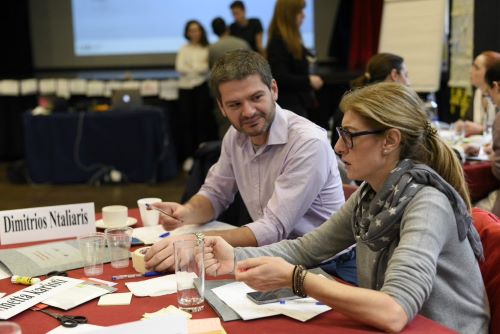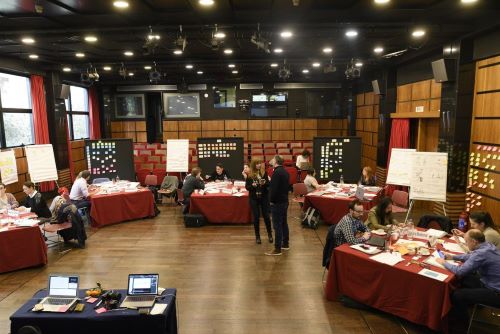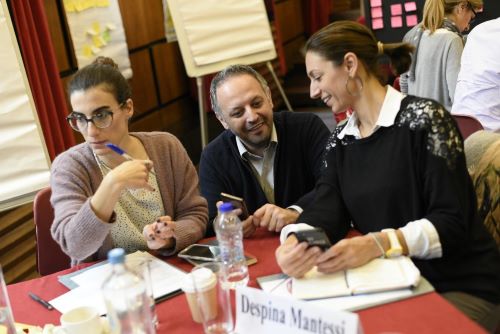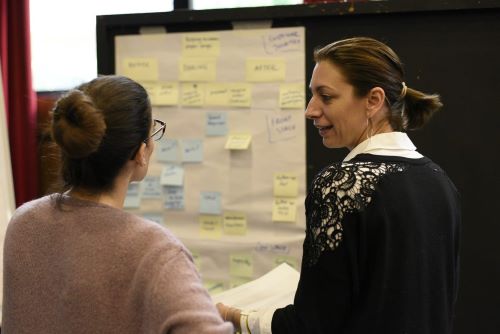Empower your creativity and problem solving skills with Design Thinking
"Design thinking can be described as a discipline that uses the designer's sensibility and methods to match people's needs with what is technologically feasible and what a viable business strategy can convert into customer value and market opportunity."
- Tim Brown, CEO of IDEO
Are you passionate with innovation? Do you want to create products or services that truly resonate with your customers?
Do you want to learn a proven methodology that can help you solve complex problems and drive growth in your organization?
Learn the principles and practice of design thinking in our 18-hour workshop, offered in partnership with GBMC and led by a Design Thinking Certified Professional Trainer. Learn how to identify user needs, generate innovative ideas, prototype and test solutions, learn a new approach to problem-solving.
In house solution
This course is offered only as an in house solution to align with your company's training needs.




This course is offered in association with Global Business Management Consultants (GBMC). GBMC, established in 1985, is an elite international project management consultancy, working with senior executives at leading organizations in more than 50 countries, in 14 languages throughout Asia, Europe, the Middle East and the Americas.
Design Thinking is a way of life.
Design Thinking encourages you to think outside the box and solve complex problems, it fosters your innovation traits, it cultivates empathy, collaboration and boosts your growth mindset.
Being able to apply it successfully will result in an organisational cultural transformation as well as a self-revelation on your own strengths and creative thinking.
It's called "design thinking" because it's often used by designers to come up with new product or service ideas, but it can be applied to many different fields and industries. The goal of design thinking is to create solutions that are innovative, user-friendly, and effective. This is typically done by following a series of steps, such as:
Defining the problem -> Generate a large number of potential solutions –>
Selecting the most promising ideas and creating prototypes to test them –>
Gathering feedback –> refining, re-testing until a final solution is reached.
- Walk through the entire design thinking process from understanding a stakeholder group, discovering a need, testing prototypes and creating a solution to address it – whether it be a process, a service, a product, or an application
- Discover your own personal DNA through the CliftonStrengths Assessment
- Get personalized coaching and feedback from experienced facilitators
- Acquire a new shared language and methodology to communicate and collaborate with your team
- Be able to apply this knowledge to your own work and become ambassadors of fast-paced change inside your organisation.
This program is designed for both teams and individuals seeking to acquire a structured, effective approach to developing innovative products, services, processes, solutions. It is addressed to professionals responsible for growth, customer experience, engineering, product development, R&D, and UX.
Some of the roles that are ideal for this course are:
- Product Manager
- Marketing Manager
- Growth Manager
- R&D Manager
- Product Head
- Customer Relationship Manager
- HR, Learning & Development Practitioners
- Senior Designer
- UX Designers, Consultants, Engineers
- Art Directors
- Business coaches and mentors
- C-suite executives such as CEO, COO, Managing Director, Founder, President, and Chief Strategy Officers
Day 1: Preparation & Research
-
Introduction to design thinking; field research tools & techniques
-
Discovering your DNA through CliftonStrengths Assessment
Day 2: Synthesis & Concepts
-
Adopting the Seven Design Thinking Mindsets
-
Empathy at Works – Creating an Engaging Design Thinking Culture
Day 3: Testing & Takeaways
-
Apply Design Thinking through the GROW Model
-
GROW Practices and Design Thinking Outcome
As part of the pre-workshop preparation, you will use a code to participate in an online Clifton Strengths Assessment (CSA) to understand your talents and get your own personal strengths report.
This is a critical step to the Design Thinking adoption and engagement. By understanding your personal strengths, it will enable you will better interact with stakeholders, and even improve your every day work life interactions.
The GROW acronym stands for G: Goals, R: Reality, O: Options and W: Will. The GROW Model is a coaching, problem solving and synergetic tool, created by Sir John Whitmore and his team in the late 1980s. Widely used by academia, leaders and coaches all over the world, this model helps people identify personal goals and achieve them through a synergetic approach.
Applied in Design Thinking, GROW model helps us understand what is our real goal, our inner desire, and strengthens our commitment to find the solution. This approach boosts self confidence, self-motivation, productivity and the sense of self fulfilment.
Some of the techniques we will also learn and practice:
- Interviewing techniques
- Focus Groups
- Observations
- Consumer journey
- Surveys
- Mind maps
- Brainstorming
- Cause-effect diagrams
- Prototyping
- Testing
Extremely applicable to design services and provide solutions while having and end users in mind User Experience Design Architect, PMI.COM
A whole new practical way of applying design thinking into finding solutions and getting to know your customer’s needs Digital Art Director
An eye-opening workshop experience that focused on implementable design techniques, while conducted by a passionate and engaging team of instructors. Head of Customer Service Operations, Alpha Bank
We all need to be able to understand our business environment and empathize our stakeholders and/or clients, and this is a great, structured way of working to achieve a better understanding and results. Head of Marketing and Product Development, Chrysi Efkairia
Dr Sherman Ong has held senior management positions in various industries, including High Technology Aerospace and Defense Manufacturing, Information Technology and Communications, Public Healthcare, ...
Learn moreYou might be interested ...
Shopping Basket ({{count}})
-
{{item.Title}}{{item.Description}}Price: {{item.Price}}Quantity: {{item.Quantity}}
